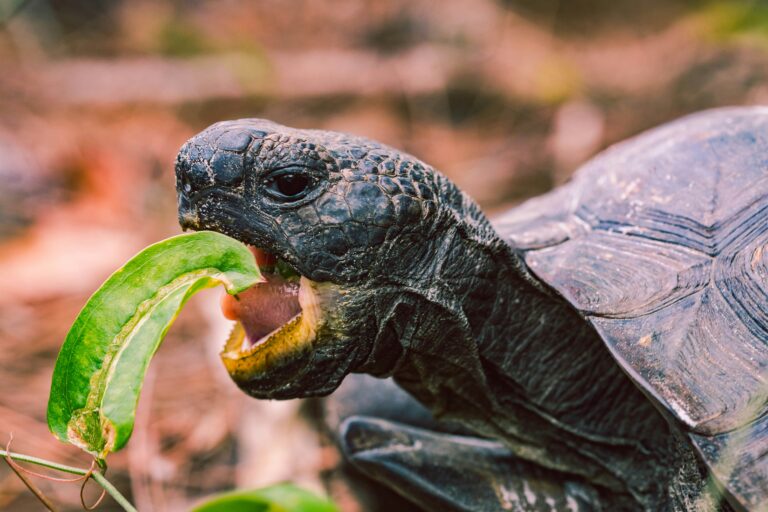What do Russian tortoise eat? 2 Healthy foods

With their fascinating beauty and distinct nutritional requirements, Russian tortoises are a delightful challenge for pet owners. Understanding what these lovely reptiles eat is critical for their health and longevity. Join us on a culinary journey through the Russian tortoise’s diet, revealing the mysteries of its dietary requirements and favorite delicacies.
The Russian Tortoise Diet: An Overview
Russian tortoises, sometimes known as Horsefield’s tortoises, are naturally herbivorous. They feed on grasses, weeds, flowers, and succulent plants in the wild. Mimicking their natural diet is critical for maintaining their health and vitality in captivity.
Dandelion greens: Dandelion greens, which are high in vitamins A, C, and K, as well as calcium and iron, constitute an important part of the Russian tortoise’s diet. These nutrient-dense greens promote healthy digestion and immunological function while strengthening bones and shells.
Bell peppers: Bell peppers, offer color and flavor to your tortoise’s food while also providing vitamin C, antioxidants, and hydration. These crisp veggies supply critical nutrients and enhance immunity, ensuring that your Russian tortoise has a well-balanced diet.

Essential Components of a Russian Tortoise Diet:
Leafy Greens: A Russian tortoise’s diet consists primarily of dark, leafy greens. Provide a range of selections, such as dandelion greens, collard greens, mustard greens, kale, and turnips. These nutrient-dense greens provide critical vitamins and minerals while also improving intestinal health.
Vegetables: Provide your tortoise with a variety of vegetables, including squash, bell peppers, carrots, cucumber, and zucchini. These colorful additives offer diversity and flavor to their meals while also delivering extra vitamins and hydration.
Occasional Fruits: While fruits should be used rarely because of their high sugar content, your Russian tortoise can enjoy occasional treats. Provide tiny portions of fruits such as strawberries, raspberries, melon, and apples as periodic snacks or prizes.
Edible Flowers: Edible flowers not only provide an esthetic appeal to your tortoise’s diet, but they also have nutritional value. Hibiscus, roses, nasturtiums, and pansies are all safe selections. Before feeding, make sure the flowers are free of pesticides and well-cleansed.
Calcium and Vitamin Supplements: Dusting foods with calcium powder and exposing them to natural sunlight or UVB lights are critical for maintaining adequate calcium metabolism and preventing metabolic bone disease.

Feeding Guide for Russian Tortoises
Now that we’ve discussed the key components of a Russian tortoise’s diet, let’s look at some feeding tips to maintain optimal nutrition and health:
Provide Variety: Rotate food products regularly to ensure a varied range of nutrients and avoid nutritional monotony. To suit your tortoise’s nutritional demands, provide a balanced diet of leafy greens, vegetables, and occasional fruits.
Fresh Is Best: Always feed your Russian tortoise fresh, pesticide-free food. Uneaten food should be removed immediately to maintain hygiene and prevent spoiling.
Portion Control: Don’t overfeed your turtle, as obesity can cause shell deformities and organ problems. Provide food in proper portion proportions for your tortoise’s size and activity level.
Hydration: Although They get the majority of their hydration from their diet, they must always have access to fresh, clean water. Soaking your tortoise in shallow water regularly can also assist to prevent dehydration and keep it hydrated.
Monitor Health: Keep track of your tortoise’s food patterns and overall health. Any changes in appetite, behavior, or appearance may signal underlying health problems that necessitate veterinary intervention.
Conclusion: Feeding your Russian Tortoise
To summarize, understanding what they eat is critical to providing them with a balanced and nutritious diet. By providing a mix of leafy greens, vegetables, occasional fruits, and edible flowers, you can guarantee that your tortoise gets enough vitamins, minerals, and water. Remember to supply calcium and vitamin supplements as needed, and keep a close eye on your tortoise’s health for any signs of food deficits or disease. With regular nourishment and care, your Russian tortoise will grow and bring you joy for many years.
Read More: Are Russian tortoise good pets?